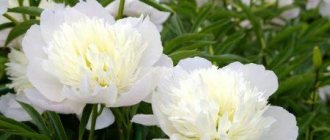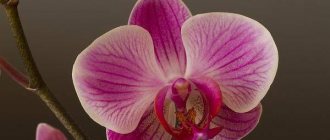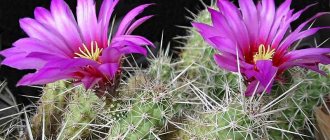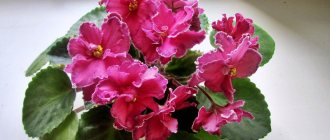Popularity of orchids for growing at home growing every year. And more and more flower growers are looking for rarer and more elite species.
Many people are interested in tiger orchids, namely, the names of specific orchid species. As Wikipedia kindly informed us, the group of tiger orchids includes the following:
- Elleanthus hymenophorus : native to the Neotropics.
- Grammatophyllum speciosum , native to southeast Asia.
- Maxillaria cucullata : native to the neotropics.
- Rossioglossum grande (aka Odontoglossum Grande): native to Central America.
They all have something of a tiger coloration, but judging by the number of photographs on the Internet, then most often the tiger orchid means Grammatophyllum speciosum, and it is its photographs that are often posted in articles on this topic.
Rossioglossum grande - photo and description of the species
In this article we will take a closer look at the last of the above list of “tiger” orchids - Rossioglossum major . This incredible plant has a number of features that set it apart from other orchids.
If they are not taken into account when growing at home, then at a minimum, you will have to wait a long time for flowering , and at maximum, the plant can be harmed or ruined. So how does the Tiger Rossioglossum ? Description of the variety and care at home will be described in detail in this article.
Rossioglossum grande in person.
Short description
Rossioglossum grande was discovered in Guatemala in 1839 and named after John Ross. It is a close relative of odontoglossum. This amazing plant blooms with large, glossy flowers throughout the fall months. Vertical peduncles bear about six flowers. In the photo you can see what this incredible orchid looks like.
The plant itself is robust and robust with dark green foliage and large pseudobulbs. Currently, large Rossioglossum is rarely found in cultivation , which makes it even more desirable and exclusive. Interestingly, in its homeland, the plant is called “tiger’s mouth.” It is also listed as a protected species (II, CITES).
Available colors
Very bright and beautiful photo of Rossik.
Tiger orchid flowers
- Glossy;
- Bright yellow;
- Greenish with red-brown;
- A variegated pattern of spots and strokes on the petals.
Lip happens:
- White;
- Or creamy;
- Sometimes with brown spots.
Reviews
Pavel, Moscow: “ My collection was replenished with another copy a month ago. The plant came from a German nursery and cost a considerable amount of money. It’s not that I really need it, but when you start collecting different kinds of orchids in your house, it becomes very difficult to stop. Due to the fact that, together with the odontoglossum, they come from a similar area, I placed them nearby - this makes it easier to maintain the desired microclimate. It is worth noting that Rossioglossum has established itself as a demanding representative of the family. I think that I will be able to get it to bloom without much difficulty.”
Marina, St. Petersburg: “ In St. Petersburg, the summer was rainy, cloudy with little light and heat. But I really hope that this was enough for the dew, because I really want to see it bloom in person - I do what I can. I feed it once a month, it responds well to spraying and artificial lighting. Let's see what comes of all this."
Anatoly, Yekaterinburg: “ I was very lucky, because on a business trip I managed to get a blooming Rossioglossum. The flowers are simply stunning, you can’t take your eyes off them. The plant itself is strong and knocked down. Much stronger than I imagined. It can be seen that in nature it grows in rather difficult conditions and requires similar treatment. It is very important not to “fall him in love” with your care and create a similar extreme in the form of cool temperatures, changing seasons, humidity, etc.”
Representatives of other orchid genera
Dendrobium Anna Green
The orchid of this species is endowed with spectacular and unsurpassed beauty. The large flowers resemble a butterfly in shape and are yellow-green in color.
At the core of this plant there is a dark purple tongue, which stands out against the background of light green flowers.
Cattleya bowringiana Green Garden (Cattleya bowringiana)
One of the most sophisticated and noble species among orchids. The petals are painted in the most delicate shade of green. The peculiarity of this flower is a kind of waxy coating, which makes the surface of the petals slightly glossy.
In the “green garden” variety, the petal at the core is unevenly colored lilac and light green, which makes the plant even more irresistible.
Cymbidium Green Giant
This is a separate genus of orchids that includes several different plant names. Among these flowers there are species with greenish petals and a tiger tongue.
Avid flower growers highly value the Sessa green variety; it is these orchids whose petals are colored richly green.
Brassavola digbyana
This orchid stands out brightly with long greenish petals and a shaggy lip. Brassavola also exudes a very subtle and unique aroma. This hybrid is primarily bred by experienced gardeners for cutting, as flower arrangements with this orchid variety look impressive and remain fresh for a long time after cutting.
Green orchids are a real highlight of the home flower collection. There are very few such natural colors in nature, so these varieties of orchids are an excellent find for exotic lovers.
Botanical characteristics
The genus Rossioglossum is quite young in the orchid family. Six species of plants were bred in 1976 from the genus Odontoglossum. Three more species joined already in 2002. Like its relative odontoglossum, rossioglossum is a sympodial epiphyte, less often a medium-sized with a short root system.
Rossioglossum is a sympodial epiphyte, less often a lithophyte.
Pseudobulbs of this orchid:
- Large sizes;
- Egg-shaped;
- Flattened;
- Gathered in tight groups.
Attention! Pseudobulbs shrink and lose leaves with age, but remain plump. There is no need to remove them; these organs retain moisture in the tissues and serve as support for the younger generation of pseudobulbs.
Each bulb is up to 6 cm in height, bears from one to three leaves :
- Dense;
- Leathery;
- Lanceolate;
- Pointed;
- Dark green in color, sometimes with a bluish tint.
Leaf length is about 30 cm, width 3-5 cm.
Peduncles:
- Erect;
- Sturdy;
- They grow from the base of the pseudobulb.
The length of the peduncle is up to 25-30 cm, the inflorescence is a raceme that usually bears 6 flowers, but can grow up to 12 pieces.
An example of growing Rossioglossum in a pot.
The flowers themselves:
- Large;
- 10-15 cm in diameter;
- They open up gradually.
The petals of the flower are wide open , with a wavy edge and rounded or pointed tips. The color is yellow-red-brown, the pattern is similar to brindle.
Lip:
- Sedentary large;
- Fan-shaped;
- Three-lobed cream;
- Or brown;
- The column is pubescent.
Another large photo of Rossioglosum to illustrate the shape of the flowers.
What is the difference from other types of orchids?
The main factor that clearly distinguishes the sugarcane variety from its counterparts is size. None of the genera of the orchid family can boast of such impressive dimensions. But there is also an original coloring of the petals.
This is interesting: all representatives of the species are characterized by the presence of serrated callous outgrowths located at the base of the lip, which is where one of the names “odons” - tooth, “glossa” - tongue was formed.
Features of flowering
Rossioglossum major blooms every nine to ten months, in the fall, around September-November. Flowering duration is 3-4 weeks, significantly reduced in hot conditions .
Stimulation
Rossioglossum is an extremely rare and demanding plant to care for. Stimulating the flowering of this orchid is far from the best solution .
In optimal growing conditions, Rossioglossum will bloom, but in unfavorable conditions, there is a significant risk of harming it or losing it.
Humidity, lighting
The tiger orchid loves moist air. In the hot season, flowers are sprayed. This is not done in cold weather, as such an action can cause dark spots to appear on the leaves or cause rotting.
The plant needs sunlight. Its quantity determines how abundantly and often the flowers on the plant will bloom.
Growing conditions and care
In nature, Rossioglossum most often lives on the trunks and branches of trees that grow in deciduous tropical forests from Mexico to Peru at altitudes of 1400-2600 meters. These areas are characterized by pronounced dry and wet periods of the year.
A characteristic feature of the wet period is:
- Large amounts of precipitation;
- And high clouds;
- As well as a limited amount of sunlight, which is filtered through clouds and tree leaves.
During the dry season, plants are exposed to cold temperatures and bright light as trees shed their leaves . There is little precipitation; orchids receive moisture only from fog and dew.
When growing Rossioglossum in culture, it should be provided with conditions for growth that are as similar as possible to natural ones .
Rossioglossum grande in a flask sells for $60.
Lighting
Rossioglossum, like its fellow odontoglossum, prefers moderate, diffuse lighting. However, make sure that your orchid is not left in the shade . It is best to place it a meter from the western or eastern window.
On the northern window you can place it on the windowsill , and on the southern window - in the back of the room. During hot summer afternoons, the plant must be shaded, otherwise there is a risk of sunburn.
It should be understood that in nature, Rossioglossums grow in low latitudes and require 12-14 hours of daylight. Therefore, for the winter it is necessary to acquire a lamp and artificially illuminate the plants .
Advice! A greenhouse or florarium will be the best place to grow your Rossioglossum.
Watering and humidity
Like odontoglossums, rossioglossums need to be watered approximately once or twice a week, depending on the weather. Care should be taken when watering. Use water :
- Soft;
- Seated;
- Or rain.
It is better to water:
- Along the edge of the pot;
- Or incomplete immersion.
The frequency of watering should be such that the substrate has time to dry completely. Pay attention to the growth of new pseudobulbs. Now Rossioglossum will need more moisture . During the dormant period, watering is reduced. Wrinkling of the pseudobulbs at this time is normal.
An example of a young plant.
Air humidity is preferable within 70-80%. Not lower than 40%, otherwise the Rossioglossum will dry out, and there will also be problems with the unfolding of new leaves . This is especially noticeable during the cold season, when central heating is turned on in apartments.
An increased level of humidity should be maintained by all available means. Place the pot in a bowl:
- With wet sphagnum;
- Expanded clay;
- Or pebbles.
Make sure that the bottom of the pot does not touch the water. Spray the plant itself with water in the morning :
- Seated;
- Rain;
- Or distilled.
Try not to let droplets from the spray bottle fall on the flowers - this can cause dark spots to appear on them. You can also purchase a humidifier to maintain humidity. The best solution would be to keep the plant in a florarium or greenhouse.
Temperature
Rossioglossums prefer cooler temperatures. In nature they grow :
- In the mountains;
- And cool forests.
The average daytime temperature during the growing season should be 22-25 °C, night temperature – 11-14 °C. During the rest period, temperatures are reduced to 20-21 °C and 9-10 °C, respectively. Obviously, temperature differences between day and night are necessary.
Large Rossioglossum is able to withstand short-term increases and decreases in temperature. Temperature extremes recorded in places of natural growth: 29.1 °C and 3 °C. However, it should be understood that these temperatures can be detrimental to flowers and the plant itself.
Advice! The circulation of fresh air, simulating natural conditions, will be beneficial for the orchid.
Feeding and fertilizer
Rossioglossums are fed with liquid mineral fertilizers for orchids in half the dosage indicated on the package. The frequency of feeding is once a month. It is unacceptable to feed the plant.
Immediately before fertilizing, it is necessary to moisten the roots of the plant , otherwise there is a risk of burning them. Once a month, dry the container with the flower to remove any remaining salt deposits. During flowering and during the dormant period, fertilizing is not carried out.
After flowering and during the dormant period
Immediately after flowering, Rossioglossum enters a rather long period of dormancy. A characteristic feature of this period is:
- Reduced humidity levels;
- Drought;
- And bright lighting.
These are the conditions that should be created for it when growing it at home or in a greenhouse.
Step-by-step instruction
- Transportation of an orchid in a flask intact and safe from Thailand to Russia.
- Place it on a windowsill where there will be suitable conditions for growth in the future (temperature, air humidity, lighting).
- Buying a pot with transparent walls to replant it.
- Substrate preparation (moss + clean fine bark/bark + coconut chips + moss). The bottom of the pot is covered with pebbles or broken pottery for drainage.
- Removing from the flask.
- Carefully place it in the pot and fill all voids in it with substrate.
- Organizing proper care for the transplanted orchid.
Before moving
Before transplantation, the vessel with the orchid is placed in the correct environment. It is placed on the windowsill, where there will be no drafts and where she is not in danger of hypothermia. They will grow it on it even after transplantation.
How many seedlings are inside the flask? 3-5 or several dozen.
Transplanting from a flask to a pot
There are several ways to remove an orchid from a flask. Some people think that the flower will not be stressed if it is taken out through a narrow neck.
Others prefer to wrap the container in cloth or newspaper and then break it by using a handy object. Who is right? The second method is preferable, since it allows you to save all the leaves that have appeared and not damage the root primordia when removing them.
Professionals act differently, pulling out seedlings by adding water to a transparent container
Also, if it is not glass, but plastic, simply cut it and take all precautions when removing fragile seedlings
- After removing the plant from the flask, free it from excess agar.
- A bunch of sprouts are washed under running tap water and then dried thoroughly using paper towels.
- The seedlings are sprayed with a solution of the fungicide Fundazol or Fitosporin.
- Wait half an hour, and then place them in a pot, sprinkled with substrate.
Attention! As soon as the seedlings are transplanted into a pot and the roots are sprinkled with substrate, move it to a warm and bright place. They are watered because they perceive a lack of moisture painfully.
Watering should be frequent.
Adult orchids are watered less often. Also, seedlings need feeding, but when preparing the fertilizer, they do not dilute it in the same proportions as in the instructions: there should be more water in it, and less active substance. If the rays of the sun rarely look into the window, you will need fluorescent lighting.
Below is a visual video about transplanting seedlings from a flask:
You will learn how to choose the right pot for this in a separate article, and read about how to plant seeds, bulbs or baby plants here.
Aftercare
After transplanting the seedlings, cover the pot with plastic wrap or glass. This is done in order to create conditions the same as in the flask; as in tropical latitudes, where it is hot but the air humidity is high.
Condensation on the walls of the pot or on the glass is dealt with by daily wiping and airing. This will prevent root rot in the seedlings.
As soon as the orchids have real roots, the care is changed. Glass or plastic film is removed and watering is reduced.
Planting, transplanting and propagation
An example of a Rossioglossum transplant.
Rossioglossum large is an epiphyte. This means that the best solution is to mount it on a block or in a basket. When planting a plant in a pot, give preference to transparent species.
Use smaller containers and a medium or fine substrate - pine bark with the addition of sphagnum. Smaller pots are more practical, since the root system of Rossioglossum prefers close quarters .
It will be very useful to make holes in the pot to increase air circulation , ventilation and saturation of the root system with moisture from the air.
Planting a plant will not cause any difficulties :
- Fill the pot 1/3 full with substrate;
- Place the plant in the pot;
- Gently distribute the roots;
- Fill the remaining voids with substrate.
Rossioglossums are replanted only as needed , when the plant has grown out of its pot or when the substrate has become unusable and has lost its qualities. It is advisable to choose the time of transplantation after a period of rest, before the start of active growing season, so that the plant has time to recover and relieve stress.
During transplantation, dry and rotten roots are removed. At the same time, you can propagate your orchid. In culture, Rossioglossum is propagated vegetatively by dividing the bush. In this case, each plant should retain at least three pseudobulbs.
Some gardeners argue that two are enough, but three will still be better. Growing Rossioglossums from seeds in home culture is not practiced .
Feeding
There are a number of conditions under which the plant is not fed. You should not apply fertilizers in the first month after transplantation. Do not provide additional nutrition to weakened flowers; It is forbidden to fertilize them during the period of active growth.
You can feed the flower using the root and leaf methods. With the root method, it is necessary to dilute the fertilizer in accordance with the instructions.
Before applying fertilizer, it is necessary to wet the substrate until the root is completely wetted, and only after that the plant is fed. To do this, use special fertilizers for orchids.
Main growing problems
An example of diseased roots of Rossioglossum.
Yellowish leaves mean the plant needs less light, while dark green leaves mean it needs more. The second factor that largely determines the health of a plant growing in an apartment is air humidity .
So, as temperatures increase, you should :
- Raise air humidity;
- And increase air circulation.
Make sure that air circulation does not turn into a draft. A draft can cause flowers and buds to drop. You should be especially careful in winter, when in apartments :
- Turn on the heating;
- And the temperature is rising;
- And the humidity drops.
Important! Be sure to provide the Rossioglossum with a sufficient period of rest, otherwise the orchid will not bloom.
Rotting of the root system is also dangerous for Rossioglossum . Flooding of the plant, the ensuing consequences and measures not taken to eliminate them can lead to the death of the orchid.
History of origin
Tiger Orchid is a tropical plant that began to grow in South America, and then began to spread in many regions of the world: Indonesia, New Guinea, Malaysia, and the Philippines.
The word “Grammatophillum”, which has a Latin origin, comes from the Greek words “gramma” - translated as “sign” and “phylum”, which means leaf.
The tiger orchid got its name from the similarity of its color to the skin of a tiger. Considering, moreover, the enormous size of the orchid, it is impossible to confuse it with other similar plants.
In nature, Grammatophyllum spreads on the forks of very large trees that can support a load of up to 2 tons. Loves the tropics, where it often rains. The weight of an adult plant can reach up to one ton . The substances necessary to nourish the root system are obtained from rain moisture, bark, fog and other various precipitation.
Diseases and pests
is affected by :
- Spider mite;
- Mealybug;
- Shchitovka.
If a plant is damaged by insects, complex insecticides should be used in the dosage indicated on the package . Use fungicides to combat diseases, fungi and rot. If a plant is damaged by a viral infection, it is disposed of.
Prevention
The best prevention is:
- Maintaining plant health;
- And keeping him in normal conditions.
The healthier it is, the less likely it is to be affected by disease or insects.
How to propagate?
There are several ways to propagate tiger orchids.
- The first method is to separate the basal baby , from which a new flower can grow.
- Branch of a baby on an orchid peduncle . You can find them on dormant buds and grow a new orchid.
- Growing a new flower from a dead one .
If an orchid dies for some reason, you should not throw it away, since on the “stump” of the orchid you can find one or two babies, from which you can get a new, more flowering plant. Children from “hemp” usually grow very well and easily accept separation and transplantation.











